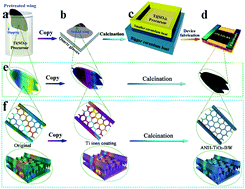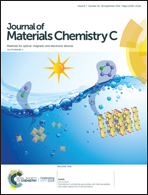TiO2 based sensor with butterfly wing configurations for fast acetone detection at room temperature†
Abstract
The amorphous/nanocrystal hybrid TiO2 based butterfly wing structure (ANH-TiO2-BW) is successfully fabricated via an easily controlled self-deposition sintering method. The hybrid configuration greatly enhances the structural toughness and maintains the original morphology throughout the experiment. The ANH-TiO2-BW configuration is very conductive to gas diffusion, and the calculated value of the diffusion coefficient (Dk) is 0.37 cm2 s−1 at room temperature (27 °C). As the completely reserved structure provides sufficient effective gas diffusion channels and gas molecule reaction sites, the ANH-TiO2-BW based gas sensor demonstrates a remarkable sensitivity to acetone, up to 1.88 at a detection limit of 5 ppm at room temperature and 180.08 for 200 ppm at an optimal operating temperature of 65 °C. Meanwhile, the device exhibits long-term stability, good cycle-to-cycle repeatability and selectivity to trace acetone at room temperature. Moreover, benefiting from the 3D penetrating porous structure, the average response time of the device is only about 1.8 s. This work may open up a new way for the design and application of toxic and harmful gas detection at room temperature.



 Please wait while we load your content...
Please wait while we load your content...